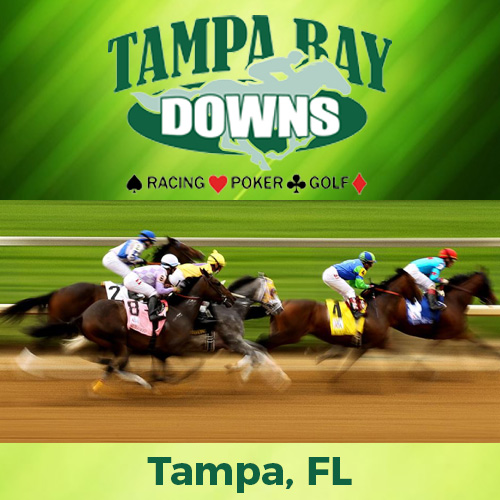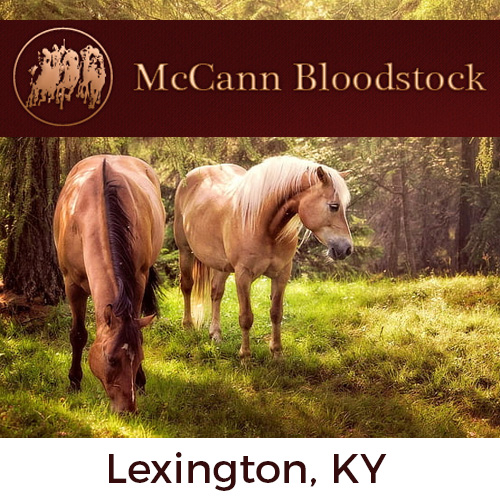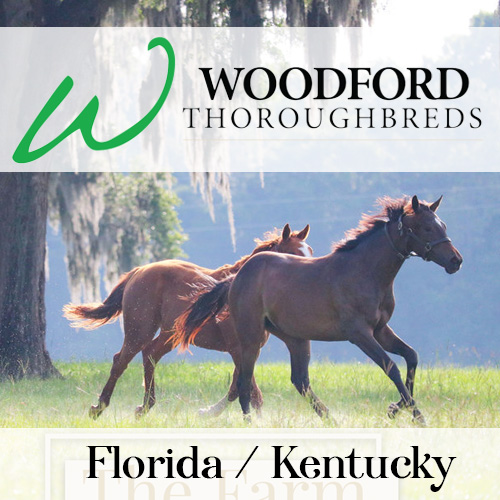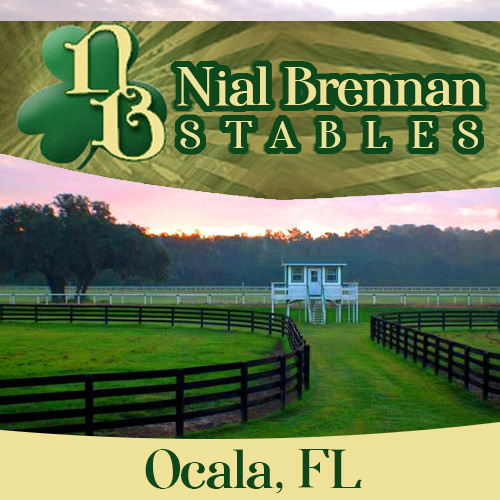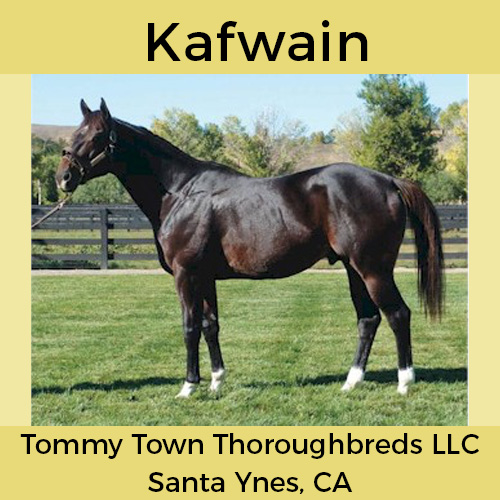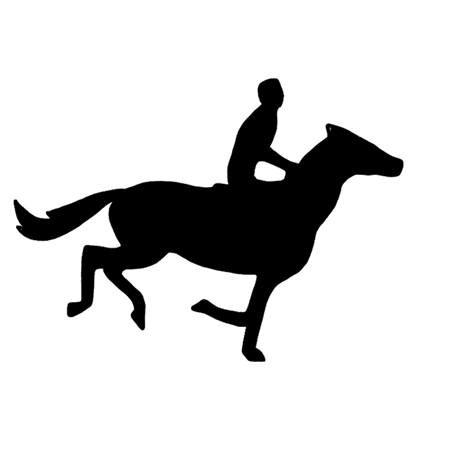Thoroughbred People's Equine Legends Series: Eclipse
Twice a month we look back on the careers of some of the great horses of yesteryear. This week - Eclipse.
By Kimberly French
Signified by a so called “ring of fire” around the sun, Eclipse’s name was derived from the particular and peculiar set of circumstances in the sky known as an annular solar eclipse on the day he was born. Still known throughout the course of history as one of the best racehorses of all-time, Eclipse also excelled in the second part of his career as a sire. Not only did he retire to the breeding shed undefeated, his impact on the breed was so tremendous more than 95 percent of today’s Thoroughbreds are descendants of the chestnut British champion.
Eclipse entered the world on April 1, 1764 and was the son of Jockey Club Plate victor Marske and the Regulus mare Spiletta, who was a granddaughter of the Godolphin Arabian. Both of Eclipse’s parents were owned by H.R.H. William, the Duke of Cumberland and the third son of King George II. Eclipse spent the first year of his life at William’s Cranborne Lodge Stud in Windsor Park in Berkshire. When he was a yearling William perished and all his stock was sold. The bright-eyed, spirited chestnut colt was purchased for 75 guineas by William Wildman, a sheep dealer from Smithfield.
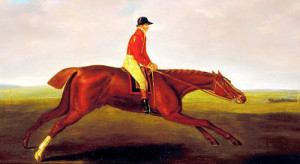 Due to his willful disposition, Wildman considered gelding Eclipse but thankfully refrained from doing so. The horse was allowed to grow, mature and develop so he did not make his racing debut until May 3, 1769 at Epsom at the age of five. Ridden by John Oakley, who it was said was the only one that could contain Eclipse’s fiery behavior or maintain his balance while Eclipse ran with his nose to the ground, he captured a plate for 50 pounds that consisted of four mile heats. Legend has it that shortly before the second heat, a betting man by the name of Dennis O’Kelly claimed the results would be, “Eclipse first, the rest nowhere.” If a horse was trailing more than 240 yards behind the leader during a racing contest, they were referred to as being “nowhere.” The phrase stuck and was still used to describe a dominating performance until several decades ago. Not only did Eclipse easily thrash his competition, he also acquired a new owner in Kelly who paid 650 guineas for half of the horse.
Due to his willful disposition, Wildman considered gelding Eclipse but thankfully refrained from doing so. The horse was allowed to grow, mature and develop so he did not make his racing debut until May 3, 1769 at Epsom at the age of five. Ridden by John Oakley, who it was said was the only one that could contain Eclipse’s fiery behavior or maintain his balance while Eclipse ran with his nose to the ground, he captured a plate for 50 pounds that consisted of four mile heats. Legend has it that shortly before the second heat, a betting man by the name of Dennis O’Kelly claimed the results would be, “Eclipse first, the rest nowhere.” If a horse was trailing more than 240 yards behind the leader during a racing contest, they were referred to as being “nowhere.” The phrase stuck and was still used to describe a dominating performance until several decades ago. Not only did Eclipse easily thrash his competition, he also acquired a new owner in Kelly who paid 650 guineas for half of the horse.
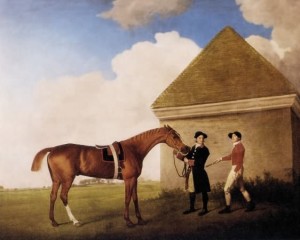 The duration of Eclipse’s first season of racing closely resembled his maiden breaking victory. In his next start he captured two mile heats at Ascot and then his first King’s Plate at Winchester in four mile heats before he collected two more triumphs for a City Plate in Winchester and a King’s Plate at Salisbury. The last two wins being walk-overs as Eclipse had so thoroughly controlled the opposition, they feared competing against him. He finished his first campaign with the City Free Plate at Salisbury in four mile heats and accrued three more King’s Plates at Canterbury, Lewes and Litchfield. He was a perfect nine-for-nine.
The duration of Eclipse’s first season of racing closely resembled his maiden breaking victory. In his next start he captured two mile heats at Ascot and then his first King’s Plate at Winchester in four mile heats before he collected two more triumphs for a City Plate in Winchester and a King’s Plate at Salisbury. The last two wins being walk-overs as Eclipse had so thoroughly controlled the opposition, they feared competing against him. He finished his first campaign with the City Free Plate at Salisbury in four mile heats and accrued three more King’s Plates at Canterbury, Lewes and Litchfield. He was a perfect nine-for-nine.
In 1770, Eclipse proved to be as elite in his first year of competition and in April O’Kelly received full ownership of the horse after supplying Wildman with 1,100 guineas. The stallion’s first engagement was a match race with Bucephalus at Newmarket over the Beacon Course, where he remained to annex the Newmarket King’s Plate in four mile heats. His next three races were all for King’s Plates at Guildford, Nottingham and York. His next start was the Great Subscription at York, run in a single four mile format subsequent to another King’s Plate walk over at Lincoln. His next stop was at Newmarket and he won two races in two days with one being another walk-over in a King’s Plate. This is when it was determined to retire him. There was no horse that could compete with Eclipse and he ended his career an unblemished 18 for 18 with 11 King’s Plates. He was hailed as one the most fantastic runners ever seen that was only equaled in prowess by Flying Childers, who actually was a full sibling to Eclipse’s great grandsire Bartlett’s Childers.
Eclipse took up stud duties in 1771 at O’Kelly’s Clay Hill Stud near Epsom and his fee was originally 50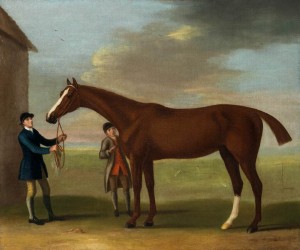 guineas. In 1778 he was relocated to another property, Cannon’s Stud in Edgeware, where he perished on February 26, 1789 at age 24 after succumbing to colic. As was customary at the time to pay tribute, Eclipse’s hooves were turned into inkstands. One such item was created from gold and presented as a goblet to the King of England. In addition, hairs from his tail were placed in Charles II’s whip.
guineas. In 1778 he was relocated to another property, Cannon’s Stud in Edgeware, where he perished on February 26, 1789 at age 24 after succumbing to colic. As was customary at the time to pay tribute, Eclipse’s hooves were turned into inkstands. One such item was created from gold and presented as a goblet to the King of England. In addition, hairs from his tail were placed in Charles II’s whip.
Although Eclipse was one of the leading sires of his day, he never actually topped that list. That distinction was reserved for Herod, who was also in the William’s dispersal and his son Highflyer. Eclipse was the sire of 344 victors, including Derby winners Young Eclipse, Volunteer and Sergeant, in additional to the top class runners and sires Pot-8-os, King Fergus, Mercury, Joe Andrews, Dungandon, Alexander, Don Quixote and Pegausus.
Only one of his female progeny, Annette won a classic when she took the Oaks in 1787, but they served as superior broodmares. They performed exceedingly well when mated with the lines of Herod and Highflyer. This cross was responsible for Haphazard, Chanticleer, Weasel, Skyscraper4, Tartar, Stamford, Archduke, John Bull, Meteora and Remembrancer.
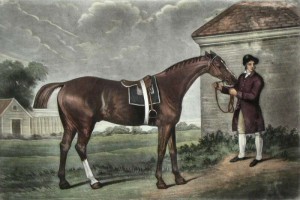 Shortly after Eclipse’s death, his body was submitted for an autopsy. If this was a direct result of the custom of the time, when only a horse’s head, heart and hooves were buried, is unknown. What was discovered, however, is that Eclipse’s heart weighed 14 pounds when most horses’ hearts weighed eight. Eclipse is considered to be the standard bearing influence of what is known in the “X Factor.” This is when a horse with a large heart develops that characteristic through the genetic transference of the X chromosome. As a sire can only pass an X chromosome on his daughters that is how the trait is inherited. It is thought that superior racehorses have larger than average hearts.
Shortly after Eclipse’s death, his body was submitted for an autopsy. If this was a direct result of the custom of the time, when only a horse’s head, heart and hooves were buried, is unknown. What was discovered, however, is that Eclipse’s heart weighed 14 pounds when most horses’ hearts weighed eight. Eclipse is considered to be the standard bearing influence of what is known in the “X Factor.” This is when a horse with a large heart develops that characteristic through the genetic transference of the X chromosome. As a sire can only pass an X chromosome on his daughters that is how the trait is inherited. It is thought that superior racehorses have larger than average hearts.
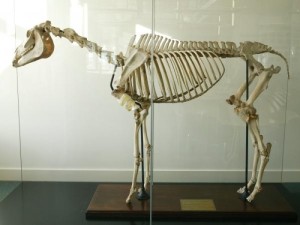 Presently, Eclipse’s skeleton can be viewed at Royal Veterinary College of Medicine (RVC). The United Kingdom’s oldest veterinary university also conducted DNA and range of motion studies on the horse’s remains to determine just what set him apart from his contemporaries. Using DNA from one of the Eclipse’s teeth, the researchers discovered his line still remains present in many of today’s horses’ genetic material. They also recreated one of Eclipse’s limbs to ascertain how he could have possessed a 25 foot stride and why he was so swift.
Presently, Eclipse’s skeleton can be viewed at Royal Veterinary College of Medicine (RVC). The United Kingdom’s oldest veterinary university also conducted DNA and range of motion studies on the horse’s remains to determine just what set him apart from his contemporaries. Using DNA from one of the Eclipse’s teeth, the researchers discovered his line still remains present in many of today’s horses’ genetic material. They also recreated one of Eclipse’s limbs to ascertain how he could have possessed a 25 foot stride and why he was so swift.
Dr. Alan Wilson, who led the study said in a 2007 press release, “All the factors for speed were perfectly matched. A key ability for a fast horse is to be able to bring its legs forward quickly, which is difficult for large animals with long limbs. Eclipse was smaller than modern racehorses. Rather than being some freak of nature with incredible properties, he was actually just right in absolutely every way."
